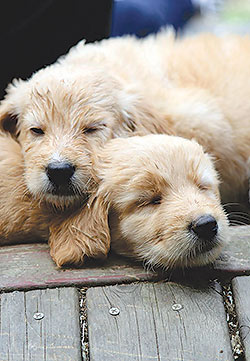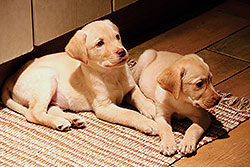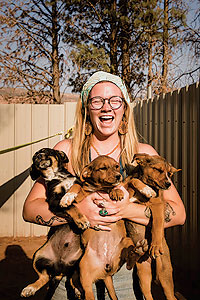 When it comes to adding a dog to your family, you may assume that two pups are better than one. However, if you asked most dog trainers and veterinarians, they would likely try to talk you out of adopting two puppies from the same litter. The truth is, there’s no right or wrong answer when it comes to adopting a sibling pair, but there are careful considerations that must be made. When it comes to adding a dog to your family, you may assume that two pups are better than one. However, if you asked most dog trainers and veterinarians, they would likely try to talk you out of adopting two puppies from the same litter. The truth is, there’s no right or wrong answer when it comes to adopting a sibling pair, but there are careful considerations that must be made.
In the right environment and with proper training and ongoing socialization, adopting two dogs from the same litter may be the perfect addition to your family. But be prepared that extra work and commitment on your part may be required.
Potential Problems With Sibling Puppies
Whole Dog Journal, detailed some of the most common reasons why dog training professionals often try to discourage would-be pet guardians from choosing a sibling pair. Among them:
• They may bond more to each other than to human family members
• Housetraining may be more difficult and require twice as much effort
• The time required to ensure each puppy gets individualized playtime, attention and training, in order to grow into a confident, social dog even when not in their sibling’s presence
Littermate syndrome is another term, based on anecdotal evidence, used to describe two siblings adopted together that bond intensely with each other, to the exclusion of their human family. Littermate syndrome is somewhat controversial, as it certainly doesn’t happen in every case, but it is something to consider, especially if pet parents are not focused on intentionally developing individual, separate relationships with both dogs.
Fighting among littermates can be severe, and should also be considered prior to bringing home two puppies from the same litter. In my experience, sibling rivalry is worse with same-sex siblings, and more pronounced in certain breeds.
One pup can also develop an unhealthy emotional dependence on the other, becoming highly anxious if he’s separated from his sibling. Whole Dog Journal’s training editor is among those who advises against adopting two puppies at once. Explaining “The biggest challenge of adopting two new puppies is their tendency to bond very closely with each other, often to the exclusion of a meaningful relationship with their humans. They can become inseparable. Also, owners often underestimate the time commitment required to properly care for and train two puppies; as a result the pups often end up untrained and undersocialized.”
How to Help Siblings Live in Harmony
If you do adopt littermates, you can help them adjust and grow into well-adjusted dogs, as well as increase bonding with you, by using separate crates, training sessions and playtime, so each dog has a chance to grow and develop on its own.
Teaching your puppies how to grow into confident, independent and secure dogs starts with separate crates, which should be in someone’s bedroom initially so you can hear them when they whine to go out in the middle of the night. Training your pups should also be done separately. “It’s much more difficult to get and keep any semblance of attention from either puppy if the other is present as a distraction. Eventually you can each work with them at the same time in the same room, and sometime in the future one person can have fun working with them both at the same time. But that’s down the road somewhere, after they’ve both learned their good manners lessons very well.”
Each puppy should also be given opportunities for individualized playtime. While they can certainly play together sometimes, allowing each pup a chance to play with you one-on-one ensure that the less assertive pup will get a chance to shine. “For example, if you always play ‘fetch’ with the two together, you’re likely to see that one pup repeatedly gets the toy and brings it back, while the other runs happily along behind.
If you watch closely, you may even see the more assertive one do a little body language warning if the other tries to get the toy — a hard stare and stiffened body, perhaps. The less assertive one defers to her sibling by letting go of the toy and looking away.”
The same is true of going for walks. You’ll need to walk each puppy individually so they can develop confidence on their own. If you don’t, and instead only walk them as a pair, “the less confident pup will come to rely on the presence of the more confident one to be brave in the real world.”
Are Two Dogs Really Better Than One?
If you can commit to the extra time and commitment that a sibling pair requires, you can likely learn to live in harmony together, but preventing sibling issues is a far better approach than managing issues once they start. A common statement I hear as a vet is, “I’ve raised many sets of siblings and never had a problem, until now.” Preventing rivalry and over-bonding should be a conscious effort when siblings come home together, beginning day one.
Another option is to adopt one dog at a time, giving each a chance to bond with you and develop into a well-socialized and trained dog before adding another pup to the mix. “Consider instead adopting one puppy now and another later, or better yet, one puppy now and an adult dog later.”
In general, if you’re considering two dogs for your household, choose dogs of the opposite sex to maintain harmony, as dogs of the opposite sex tend to get along better than same-sex pairs. Often, larger males and smaller females work well together in the same household, though you can also consider dogs of the same breed. Fortunately, when it comes time to adopt, many shelters allow you to “try before you buy,” and bring a dog home with you for a set time, to make sure you have a match made in heaven.
No matter which route you choose — a sibling pair, multiple dogs adopted at different times or a dog that’s an “only child” — make sure to ask yourself these questions and consider the answers carefully before making the big commitment of being a dog guardian:
• Has the dog you’re considering been behavior-tested?
• What is the dog’s history?
• What veterinary care has your prospective dog received?
• What are the steps involved in the adoption?
• What food has your new dog been eating?
|
 Meet Underdog Rescue at Ken’s Lake on June 25, 2022, for a day of fun in the sun. Their first annual Dog Paddle will take place at the lake with games, prizes, paddleboard yoga, food, beverages, and dogs! This dog and family-friendly event will be one you don’t want to miss as the proceeds support Underdog’s mission of rescuing dogs from the Four Corners reservation communities. Meet Underdog Rescue at Ken’s Lake on June 25, 2022, for a day of fun in the sun. Their first annual Dog Paddle will take place at the lake with games, prizes, paddleboard yoga, food, beverages, and dogs! This dog and family-friendly event will be one you don’t want to miss as the proceeds support Underdog’s mission of rescuing dogs from the Four Corners reservation communities.
Underdog is the only rescue in Utah dedicated to serving the Native American communities, including Navajo reservation land which is the largest reservation in the U.S. Over 250,000 stray dogs live on Navajo lands alone and Underdog is on a mission to save as many dogs as they can across the Four Corners area.
Located inside Moab city limits, you can support Underdog by volunteering, rescuing their many pups looking for forever homes, or supporting this event through sponsorship. If you are interested in learning more about Underdog and how you can help or want to purchase your Dog Paddle ticket, please visit the website at underdogrescuemoab.org |